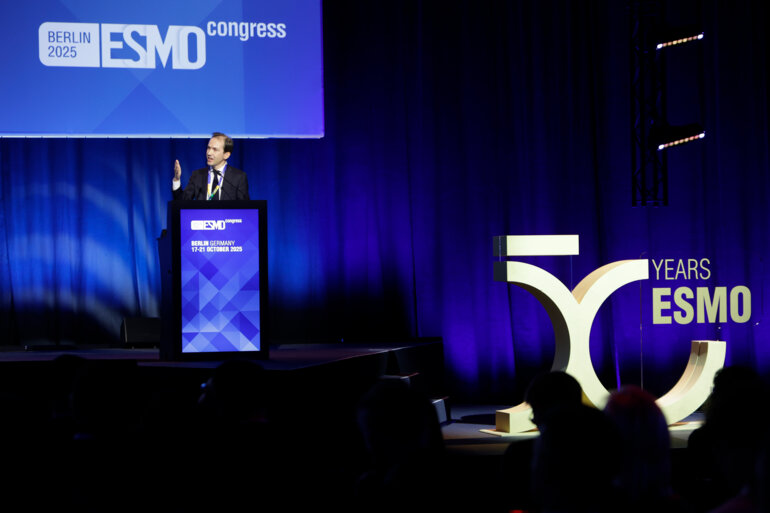Early-phase studies, COSMIC-021 and CheckMate 9KD, show promising results in men with prostate cancer, but patient selection is key
New immune checkpoint inhibitor (ICI)-based combinations show promise for patients with metastatic castration-resistant prostate cancer (mCRPC) progressing on enzalutamide and/or abiraterone, according to results from two studies presented at the ESMO Congress 2021.
Today’s presentation from expanded cohort 6 of the multinational phase Ib COSMIC-021 study reported that the combination of the multi tyrosine kinase inhibitor (TKI) cabozantinib and the anti-PD-L1 agent atezolizumab was associated with an objective response rate (ORR) of 15%, a median progression-free survival (PFS) of 5.7 months (95% confidence interval [CI] 5.4–7.0) and a median overall survival (OS) of 18.4 months (95% CI 14.3–24.7) in 132 patients with a median follow-up of 15.2 months (LBA24) (Figure). The results appear to support the premise that cabozantinib promotes an immune-permissive tumour microenvironment, enhancing the effect of checkpoint inhibition. The study also reported that frequent treatment-related adverse events (TRAEs) were diarrhoea (55%), nausea (42%) and fatigue (43%). Grade 3–4 TRAEs occurred in 55% of patients. Preliminary data suggest no association between tumour PD-L1 status and antitumour activity.
These encouraging initial results signal that the enormous progress we have made in the treatment of mCRPC in the last 15 years is continuing and that the outlook for our patients keeps getting better
In a presentation on Sunday 19 September, the CheckMate 9KD study will report that the anti-PD-1 agent nivolumab plus the PARP inhibitor rucaparib is associated with a confirmed ORR of 15.4%, a median radiographic PFS (rPFS) of 8.1 months (95% CI 5.6–10.9) and a median OS of 20.2 months (95% CI 14.1–22.8) in an unselected population of 71 patients with chemotherapy-naïve metastatic disease (Abstract 579MO). All efficacy parameters appear better in homologous recombination deficient (HRD)-positive tumours than in HRD-negative/-not evaluable tumours: ORR (25.0% versus 5.3%), median rPFS (10.9 months versus 5.6 months) and median OS (22.7 months versus 19.0 months). Grade ≥3 TRAEs occurred in 50.7% of patients, most commonly anaemia (14.1%) and increased alanine aminotransferase (12.7%).
“These encouraging initial results signal that the enormous progress we have made in the treatment of mCRPC in the last 15 years is continuing and that the outlook for our patients keeps getting better,” says Dr Dominik Berthold, Centre Hospitalier Universitaire Vaudois, Lausanne, Switzerland. However, it is still early days. “We have seen many instances – notably with cabozantinib in the results from the COMET-1 trial published in 2016 – where promise in early-phase studies did not translate into improved efficacy in phase III trials,” he cautions. Reasons for this discrepancy include the absence of a sound biological hypothesis, recruitment of patients with disease unlikely to respond well to the treatment being investigated and insufficiently rapid recruitment of patients. By capitalising on the individual strengths of academia and industry, collaborations between these parties could go some way to achieving the combination of a rigorous biological rationale and rapid enrolment that could optimise the chances of trial success.
Commenting on patient selection in the two studies, Berthold notes: “The results of the CheckMate 9KD study highlight the importance of determining the patient population most likely to respond to treatment. In this case, the initial results suggest that it is only the patients with HRD-positive tumours – that is, those harbouring mutations favouring the use of a PARP inhibitor – who derived clinical benefit from the nivolumab–rucaparib combination,” comments Berthold. “For the COSMIC-021 study, it is no great surprise that there was no apparent relationship between PD-L1 status and efficacy. Given that PD-L1 expression is heterogeneous in nature and also varies with different methodologies, the value of it as a biomarker is still being debated,” he says.
The toxicity profiles of the agents used, as reported by these two studies, are well recognised and are generally manageable. “However,” says Berthold, “we need to consider the impact that non-life-threatening adverse events have on individuals’ lives. Patients with mCRPC are generally elderly and frail and experiencing even just a bit more fatigue – as noted in 43% of patients in the COSMIC-021 study – could have a considerable negative effect on their quality of life.”
The combination of cabozantinib plus atezolizumab, compared with a second hormonal therapy, is currently being investigated in the phase III CONTACT-02 trial in patients with mCRPC previously treated with a novel hormonal therapy.
Agarwal N. Cabozantinib (C) in combination with atezolizumab (A) in patients (pts) with metastatic castration-resistant prostate cancer (mCRPC): Results of expanded cohort 6 of the COSMIC-021 study, LBA24
Proffered Paper session – Genitourinary tumours, prostate, 18.09.2021, h. 13:30 – 14:50, Channel 3
CHECKMATE 9KD cohort A2 final analysis: Nivolumab (nivo) + rucaparib for chemotherapy (CT)-naïve metastatic castration-resistant prostate cancer (mCRPC), Abstract 579MO
Mini oral session – Genitourinary tumours, prostate, 19.09.2021, h. 17:30 – 18:10, Channel 2






